Less Shocking, More Range
When BMW introduced its new i3 electric car for the 2014 model year, I was impressed, but also a little shocked. The styling, frankly, is oddball, but I think that was done intentionally to differentiate it from the Ultimate Driving Machines on the BMW lot. After three years, I’ve become accustomed to seeing them on the road.

Despite their ecological virtues, electric cars tend to be expensive, and they have a nagging issue of lack of range. The first i3 attempted to mitigate the latter by providing an optional range extender—a tiny two-cylinder engine. When you ran out of juice after 72 miles or so, it would come on and generate enough power for the electric motor to move you to a charging station—or home (about 50 more miles). The car came with a DC quick-charge plug, too, so you could add significant range in a short time, providing you could locate a handy charger.
In any case, the car was meant for urban travel duties, making it a perfect, if expensive, commute vehicle. Appropriately, this April the 2017 i3 received the World Urban Car Award—a new category in the World Car of the Year contest—at the New York Auto Show.
A New Range
For 2017, BMW offers a new version (94Ah/Ah=ampere hours) with a 33-kWh battery supplying a boost of range from 72 to 114, and a
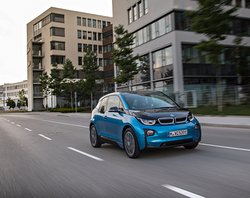
heartier range extender, which can take the car as far as 180 miles combined, per the EPA’s ratings. That helps minimize range anxiety, but it keeps your i3 from being a long-range interstate traveler. You can opt for the lower level (60Ah) with the original 22-kWh battery, if you can live with the lower range.
The drivetrain still puts out 170 horsepower and 184 pounds-feet of torque. With the instant torque delivery provided by electric motors, you can zip from 0-60 mph in just over seven seconds—which wouldn’t shame a car with the BMW roundel on its nose. You also can zip from 50 to 75 mph in 5.1 seconds—crucial for when you need passing power.
Charging times vary, but the new 33 kWh battery is full after 4.5 hours on a Level 2 charger (240 volts), a bit longer than the 3.5 hours needed by the lesser model. Hook up the new 94Ah model to a DC quick charger and you can fill it to 80 percent in just 40 minutes.
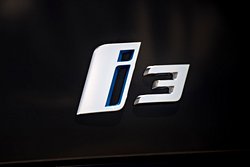
EPA numbers are 111 MPGe for electric driving and 35 mpg for the gas engine. Green ratings are 8 for Smog and 10 for Greenhouse Gas. The car emits 29 grams of CO2 per mile, but compare that to a normal gasoline vehicle at around 400 grams, and that’s a huge and important difference.
Give It a Brake
My 2017 BMW i3 tester was the 94Ah model in the new Protonic Blue, with Frozen Grey accents. I drove it for commuting and on a couple of local trips, and it handled the job very nicely.
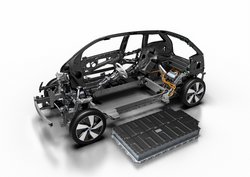
There is significant regeneration when you lift your foot off the accelerator, so you can use one-pedal driving sometimes. However, unlike the Chevrolet Bolt EV, the regen drops off at low speeds, so you can’t roll to a full stop without touching the brake pedal, like you can in the Chevy. This is more “normal” behavior, but if you’re used to heavy regen, can be a little unnerving.
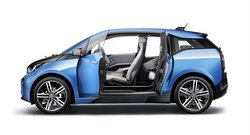
The rear “suicide” doors are hinged at the back, and provide a nice, open access to the car, but can create interesting issues when you’re parked near another car in the lot, especially when loading children. However, once everyone is settled in, there’s plenty of room, and the silent drivetrain makes conversation easy.
The interior, like the outside, is polarizing. The undulating dash with open-pore eucalyptus wood (in upper-level models), with a flat info screen in the center, is clean and stylish. The odd kenaf material on the dash and doors takes some getting used to, but it gives the car green cred by being made of recycled materials.
Worlds of Difference
There’s a base Deka World interior, but you can upgrade to three other levels, or “worlds.” Mega World ($1,400) adds 19-inch special alloys
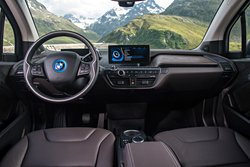
and a Carum Spice Gray Sensatec (artificial leather) interior. Giga World ($1,800) steps it up with eucalyptus wood trim and Cassia natural leather and cloth. The Tera World ($2,600) takes it further with Dalbergia Brown full natural leather and Dark Oak wood trim.
Prices begin at $43,395 for the lower-range model without range extender. My tester started at $48,445, but with Giga World, the Parking Assistance Package, the Tech Driving and Assist Package, and range extender, came to $54,295.
It still looks odd, but with increased range, the 2017 BMW i3 still commands your attention, and may work well for your needs.
Related Stories You Might Enjoy:
Road Test: 2017 Hyundai Ioniq Electric
Personal: My Chevrolet Bolt EV—A Six-month Update
News: First Tesla Model 3 Deliveries
Disclosure:
Clean Fleet Report is loaned free test vehicles from automakers to evaluate, typically for a week at a time. Our road tests are based on this one-week drive of a new vehicle. Because of this we don’t address issues such as long-term reliability or total cost of ownership. In addition we are often invited to manufacturer events highlighting new vehicles or technology. As part of these events we may be offered free transportation, lodging or meals. We do our best to present our unvarnished evaluations of vehicles and news irrespective of these inducements.
Our focus is on vehicles that offer the best fuel economy in their class, which leads us to emphasize electric cars, plug-in hybrids, hybrids and diesels. We also feature those efficient gas-powered vehicles that are among the top mpg vehicles in their class. In addition, we aim to offer reviews and news on advanced technology and the alternative fuel vehicle market. We welcome any feedback from vehicle owners and are dedicated to providing a forum for alternative viewpoints. Please let us know your views at publisher@cleanfleetreport.com.

8 thoughts on “Road Test: 2017 BMW i3 Electric”